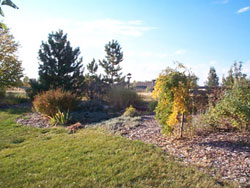A visual screen in the landscape can help create privacy and also block out unwanted views or sounds.
 The major consideration in whether to create a screen is the amount of space you have available. Even a simple hedge will need a minimum of 3 feet for a planting bed.
The major consideration in whether to create a screen is the amount of space you have available. Even a simple hedge will need a minimum of 3 feet for a planting bed.
Small residential landscapes may not offer sufficient room for an effective plant screen. If you have only a small amount of space, a vigorously growing vine such as silver lace on wire fencing creates an effective plant screen.
Another important consideration is how dense you want your screen to be. Plants that lose their leaves every year will create a see-through screen, especially in the winter. Evergreen plants are more dense, while wood fencing or masonry block are the most dense. The two major factors to consider if you construct a screen with wood or masonry materials are the expense and maintenance that is needed. The initial cost of a masonry wall is higher than a plant screen, but once installed, a masonry wall requires very little maintenance. It also blocks out sounds much more effectively than wood or plants. Wood is less permanent than masonry. Wood may be the best choice if you need screening for only a few years while plants mature or you need time to consider whether to add an addition to your home.
Wood needs to be treated with a sealer to increase its lifespan and good looks. This maintenance is vitally important in dealing with our high-altitude sunshine. In general, masonry or stone are more environmentally appropriate materials than wood in the high plains semi-arid climate of Colorado.
For more information, see the following Colorado State University Extension fact sheet(s).



